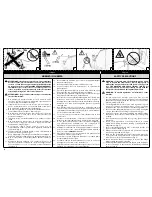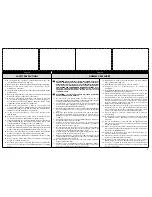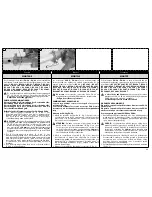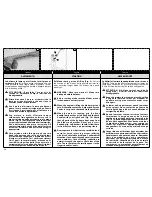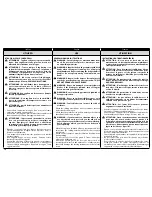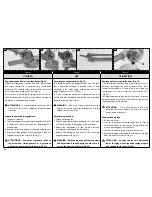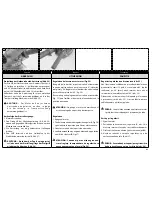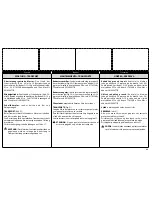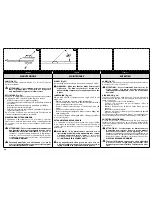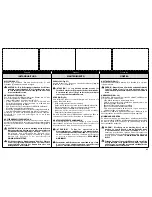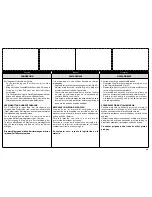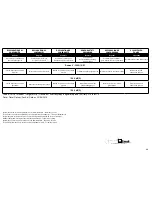
18
25
26
27
28
Italiano
English
Français
UTILIZZO
USE
UTILISATION
• Se si colpisce un corpo estraneo o in presenza di forti
vibrazioni, fermare immediatamente l’apparecchio.
Scollegare il cavo bobina dalla candela. Verificare che
l’apparecchio non sia danneggiato. Riparare eventuali
danneggiamenti.
• Se qualcosa si inceppa nelle lame mentre si sta lavorando,
spegnere il motore e attendere finché non si è fermato
completamente prima di pulire le lame. Scollegare il cavo
bobina dalla candela.
• Indossare sempre guanti protettivi da lavoro quando si
ripara l’apparato di taglio (Fig. 25) perché è estremamente
affilato e può tagliare facilmente.
• Rilasciare la leva dell’acceleratore non appena terminata
l’operazione di taglio e mantenere il funzionamento del
motore al minimo. Se si fa funzionare il tagliasiepi con il
motore a pieno regime senza un carico di taglio, si può
provocare un’inutile usura o danneggiamento della lama e
del motore.
• Se dei rami grossi o altri oggetti inceppano le lame,
spegnere immediatamente il motore prima di cercare di
liberare le lame.
• Mantenere una presa adeguata (B, Fig.26) sul tagliasiepi
mentre il motore è in funzione. Le dita devono avvolgere
l’impugnatura, mentre i pollici devono passare sotto
l’impugnatura.
• Nota: Il tagliasiepi può essere utilizzato anche senza
impugnatura. In tal caso, smontare l’impugnatura e
durante il lavoro afferrare sempre con la mano sinistra la
zona della guaina anteriore (C, Fig. 27).
CAUTELA! - Appoggiare sempre la macchina sul
terreno con motore spento e come indicato in Fig. 28.
Stagione di taglio
Osservare tutte le norme e ordinanze nazionali e locali
relative al tagliasiepi.
• If any foreign object is hit or if high vibrations occur stop
the machine immediately. Disconnect the HT lead from
the spark plug. Check that the machine is not damaged.
Repair any damage.
• If anything jams in the blades while you are working,
switch off the engine and wait until it has stopped
completely before cleaning the blades. Disconnect the HT
lead from the spark plug.
• Always wear heavy-duty gloves when repairing the cutting
attachment (Fig.25). This is extremely sharp and can easily
cause cuts.
• Release the throttle trigger as soon as the cut is completed,
allowing the engine to idle. If you run the hedge trimmer
at full throttle without a cutting load, unnecessary wear or
damage can occur to the blade and engine.
• If the cutter blades become jammed by thick branches or
any other obstruction, switch off the engine immediately
before attempting to free the blades.
• Maintain a proper grip (B,Fig.26) on the hedge trimmer
whenever the engine is running. The fingers should
encircle the handlebar and the thumb is wrapped under
the handlebar.
• Note: The hedgetrimmer can also be used without the
handgrip. In this case, remove the handgrip and hold the
front sheath area (C, Fig. 27) with your left hand during
operation.
CAUTION! - Always set the machine on the ground
with the engine switched off and as shown in Fig. 28.
Cutting season
Observe all country-specific and local regulations and
ordinances regarding hedge trimming.
• Si vous heurtez un corps étranger ou en présence de fortes
vibrations, arrêtez immédiatement l’appareil. Débrancher
le câble bobine de la bougie. Vérifiez que le taille-haies
n’est pas endommagé ou fissuré. Réparer éventuellement
les dommages.
• Si quelque chose se bloque dans les lames alors que vous
travaillez, éteindre le moteur et attendre l’arrêt complet
avant de nettoyer les lames. Débrancher le câble bobine
de la bougie.
• Porter toujours des gants de travail quand vous réparez
l’appareil de coupe (Fig. 25) car il est extrêmement affûté
et peut couper facilement.
• Relâcher le levier de l’accélérateur dès que vous
avez terminé l’opération de coupe et maintenir le
fonctionnement du moteur au ralenti. Si vous utilisez le
taille-haies à plein régime sans une charge de travail, vous
pouvez provoquer une usure inutile ou endommager la
lame et le moteur.
• Si des branches grosses ou autres objets enrayent les
lames, éteindre immédiatement le moteur avant de
chercher à libérer les lames.
• Maintenir une prise adéquate (B, Fig. 26) sur le taille-haies
pendant le fonctionnement. Les doigts doivent venir
enserrer la poignée et le pouce s’enrouler sous la poignée.
• Remarque : Il est possible d'utiliser le taille-haies sans la
poignée. Dans ce cas, démonter la poignée et toujours
saisir la zone de la gaine avant (C, Fig. 27) de la main
gauche.
ATTENTION ! - Ne poser le taille-haies au sol qu'après
avoir coupé le moteur, comme l'indique la Fig. 28.
Saison de coupe
Observer toutes les normes et les ordonnances nationales et
locales concernant le taille-haies.



